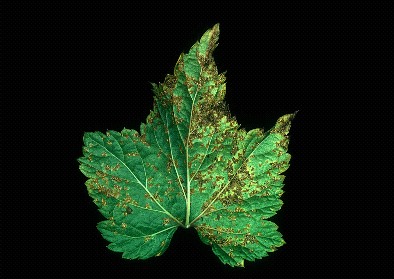
Rust (Cronartium ribicola)
Ribes spp. occupy an important role in the lifecycle of this disease, and as a result there is an urgent need for resistant cultivars for areas where susceptible pines are grown. The generally observed symptoms of infection on Ribes are lesions and developing uredinia on the leaf abaxial surfaces, with eventual loss of leaves. However, the implications for forestry plantations of susceptible Pinus spp. are often more serious, leading to death of trees and unviable plantations. Further details of the origin and spread of this fungus can be found in Hummer (2000) and other contributions in the same journal.

A dominant gene for resistance to C. ribicola, designated Cr, was found in R. ussuriense, and was incorporated in commercial blackcurrant germplasm in Canada in the 1940s, leading to the resistant cultivars 'Consort', 'Coronet' and 'Crusader'. Further development in Sweden produced the resistant cultivar 'Titania', and breeding for rust resistance is now increasing in importance.
References
- Hummer KE (2000) History of the origin and dispersal of white pine blister rust. HortTechnology 10, 515-517.
